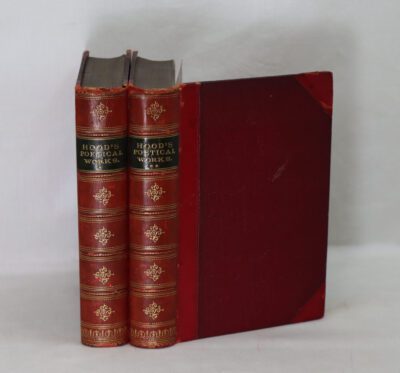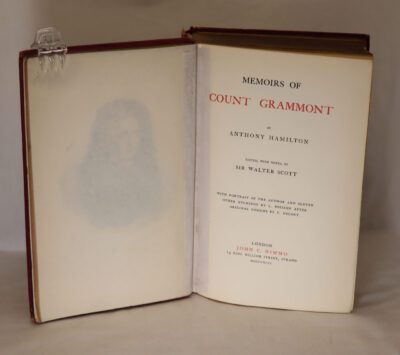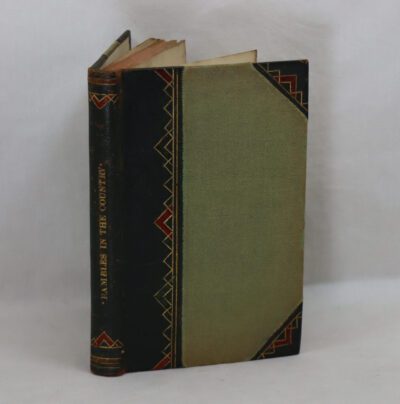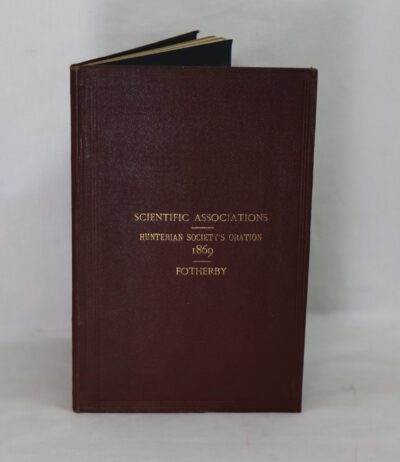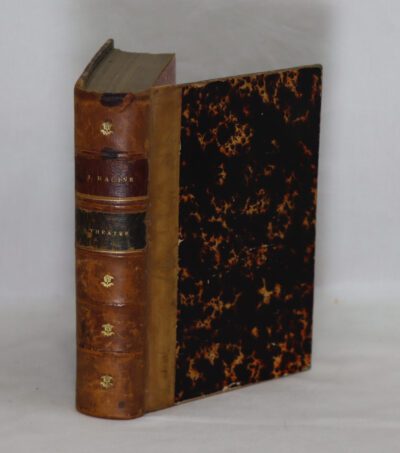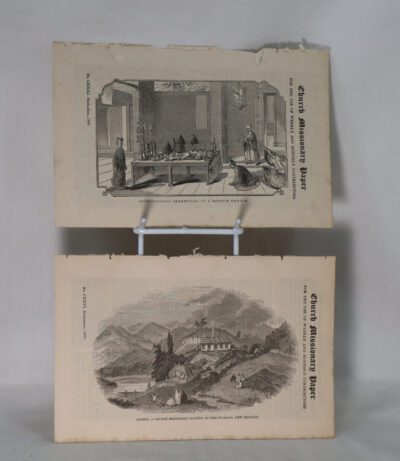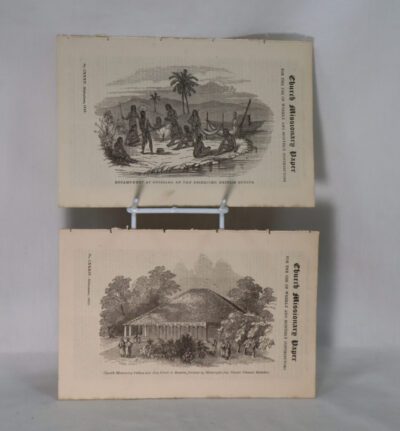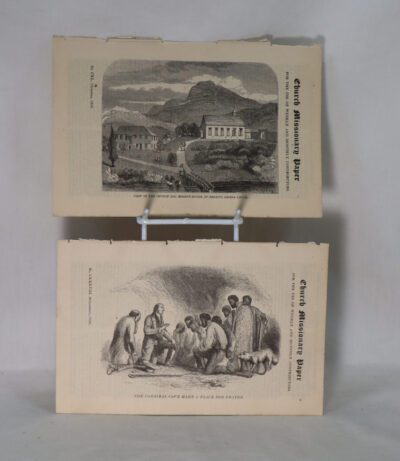Tom Brown's School Days.
By Thomas Hughes
Printed: 1894
Publisher: Macmillan. London
| Dimensions | 14 × 20 × 3 cm |
|---|---|
| Language |
Language: English
Size (cminches): 14 x 20 x 3
Condition: Fine (See explanation of ratings)
Your items
Item information
Description
Green cloth binding with gilt title on the spine.
-
F.B.A. provides an in-depth photographic presentation of this item to stimulate your feeling and touch. More traditional book descriptions are immediately available.
This edition. London: Macmillan and Co. Limited, 1894. Later Edition. Externally, sound with slight rubbing. Internally firmly bound. Pages are generally bright and clean. Condition – Externally Spine good condition. Corners good condition bumped and worn. Boards good condition gently marked, gilt crest to the front board. Page edges in very good condition marbled. See above and photos.
Tom Brown’s School Days (sometimes written Tom Brown’s Schooldays, also published under the titles Tom Brown at Rugby, School Days at Rugby, and Tom Brown’s School Days at Rugby) is a novel by Thomas Hughes, published in 1857. The story is set in the 1830s at Rugby School, an English public school. Hughes attended Rugby School from 1834 to 1842.
The novel was originally published as being “by an Old Boy of Rugby”, and much of it is based on the author’s experiences. Tom Brown is largely based on the author’s brother George Hughes. George Arthur, another of the book’s main characters, is generally believed to be based on Arthur Penrhyn Stanley (Dean Stanley). The fictional Tom’s life also resembles the author’s, in that the culminating event of his school career was a cricket match. The novel also features Dr Thomas Arnold (1795–1842), who was the actual headmaster of Rugby School from 1828 to 1841.
Tom Brown’s School Days has been the source for several film and television adaptations. It also influenced the genre of British school novels, which began in the nineteenth century, and led to fictional depictions of schools such as Mr Chips’s Brookfield, and St Trinian’s. A sequel, Tom Brown at Oxford, was published in 1861.
Tom Brown is energetic, stubborn, kind-hearted and athletic, rather than intellectual. He follows his feelings and the unwritten rules of the boys. The early chapters of the novel deal with his childhood at his home in the Vale of White Horse. Much of the scene setting in the first chapter is deeply revealing of Victorian Britain’s attitudes towards society and class, and contains a comparison of so-called Saxon and Norman influences on the country. This part of the book, when young Tom wanders the valleys freely on his pony, serves as a contrast with the hellish experiences in his first years at school.
Illustration by Godefroy Durand for the 1875 French edition of the novel
His first school year is at a local school. His second year starts at a private school, but due to an epidemic of fever in the area, all the school’s boys are sent home, and Tom is transferred mid-term to Rugby School.
On his arrival, the eleven-year-old Tom Brown is looked after by a more experienced classmate, Harry “Scud” East. Tom’s nemesis at Rugby is the bully Flashman. The intensity of the bullying increases, and, after refusing to hand over a sweepstake ticket for the favourite in a horse race, Tom is deliberately burned in front of a fire. Tom and East defeat Flashman with the help of Diggs, a kind, comical, older boy. In their triumph they become unruly.
There was also a pretty vicious Six of the Best caning.
In the second half of the book, Dr Thomas Arnold (1795–1842), the historical headmaster of the school at the time, gives Tom the care of George Arthur, a frail, pious, academically brilliant, gauche, and sensitive new boy. A fight that Tom gets into to protect Arthur, and Arthur’s nearly dying of fever, are described in detail. Tom and Arthur help each other and the friends develop into young gentlemen who say their nightly prayers, do not cheat on homework, and play in a cricket match. An epilogue shows Tom’s return to Rugby and its chapel when he hears of Arnold’s death.
A main element of the novel is Rugby School, with its traditions, and the reforms that were instituted there by Dr Arnold (1795–1842), the headmaster of the school from 1828 to 1841. He is portrayed as the perfect teacher and counsellor, and as managing everything behind the scenes. In particular, he is the one who “chums” Arthur with Tom.
The central theme of the novel is the development of boys. The symmetrical way in which Tom and Arthur supply each other’s deficiencies shows that Hughes believed in the importance of physical development, boldness, fighting spirit, and sociability (Tom’s contribution) as well as Christian morality and idealism (Arthur’s).
The novel is essentially didactic and was not primarily written as entertainment. As Hughes said:
‘Several persons, for whose judgment I have the highest respect, while saying very kind things about this book, have added that the great fault of it is ‘too much preaching’; but they hope I shall amend in this matter should I ever write again. Now this I most distinctly decline to do. Why, my whole object in writing at all was to get the chance of preaching! When a man comes to my time of life and has his bread to make, and very little time to spare, is it likely that he will spend almost the whole of his yearly vacation writing a story just to amuse people? I think not. At any rate, I wouldn’t do so myself. — Thomas Hughes, Preface to the sixth edition’
Impact
Although there were as many as 90 stories set in British boarding schools published between Sarah Fielding’s The Governess, or The Little Female Academy in 1749 and 1857, Tom Brown’s School Days was responsible for bringing the school story genre to much wider attention. Tom Brown’s School Days’ influence on the genre of British school novels includes the fictional schools of Billy Bunter, Mr. Chips, St. Trinian’s, and Harry Potter series.
The book contains an account of a game of rugby football, the variant of football played at Rugby School (with many differences from the modern forms). The book’s popularity helped to spread the popularity of this sport beyond the school.
In Japan, Tom Brown’s School Days was probably the most popular textbook of English-language origin for high-school students during the Meiji period (1868–1912). In 1899, an abridged version of the book (omitting chapter 9 of part 1, and chapters 5 and 7 of part 2) was published in Japanese translation. A subsequent, two-part, Japanese translation by Tsurumatsu Okamoto and Tomomasa Murayama appeared in 1903 and 1904, which, in addition to the previous omissions, also omitted the scene at the cricket match, due to the translators’ stated ignorance of the game of cricket. In the preface to this version, the translators praised the British education system, citing the friendship between Tom and Dr Arnold as an example of how to raise a great nation. Another partial translation, consisting only of part 1 of the book, was released in 1912 by schoolteacher Nagao Tachibana. A fourth translation, also abridged, by Sada Tokinoya arrived in 1925. Finally, a complete translation was released in 1947 that eventually ran to ten separate editions.
Thomas Hughes QC (20 October 1822 – 22 March 1896) was an English lawyer, judge, politician and author. He is most famous for his novel Tom Brown’s School Days (1857), a semi-autobiographical work set at Rugby School, which Hughes had attended. It had a lesser-known sequel, Tom Brown at Oxford (1861).
Hughes had numerous other interests, in particular as a Member of Parliament, in the British co-operative movement, and in a settlement—Rugby, Tennessee, USA—reflecting his values.
Want to know more about this item?

Related products
Share this Page with a friend





